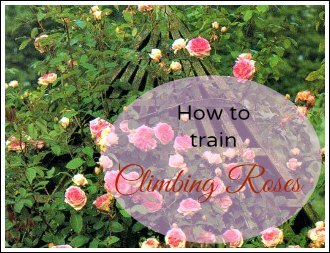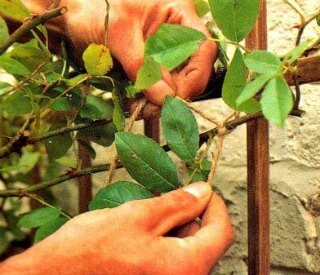How To Train Climbing Roses
Most roses don't climb on their own, it is
important to know how to train climbing roses.

Roses are often pliable enough to weave through their supporting structures, but to get a good number of flowering shoots from top to bottom I would not recommend it.
Roses tend to bloom upward at the end of their growing tips when left alone. To encourage flower production they should be trained horizontally with their tips bent down to make side-shoots grow.
To get the best blooming results from climbers, we have to know the growing differences between once-blooming and repeat-blooming varieties.
How To Train Climbing Roses: Once-Blooming Climbers
Once-bloomers have pliable canes with the advantage that we can easily lead them in any direction. They flourish heavily and don’t form irritating laterals.
They are perfect for arches, pergolas and fences. Trained to them, the roses will show solid foliage even at the bottom parts of the plants.
Tie the canes in a loose and well-regulated way to the climbing aid, and the flower buds at the young shoots will show a good development.
The young shoots should be fixed properly to the climbing structure. Once it comes to pruning, they can properly be cut without injuring them.
How To Train Climbing Roses: Repeat-Blooming Climbers
Because of the various types of repeat-blooming climbing roses, we should respect their growing habit.
Types of vigorous growth should never be vertically attached to their climbing aid. To receive blossoms at the bottom parts of the plant, the canes should be trained in a 30-degree fan-shaped way, thus they will bud homogeneously.
Types of moderate growth can be attached to vertical support structures such as pillars or walls. Removing their weak and redundant shoots during the growing period will keep them orderly and maintain their vigor.
Rose Gardening Materials And Support Structures
Rose Gardening Materials

I use twine or coconut-twine for sturdy canes, but I like to fix thin and new shoots with gardening clips. They are easy to use and can be readjusted with little effort.
Be prepared to follow the canes when they grow up an arch or an arbor. You may need a suitable ladder or a stepping stool.
Not every rose has thorns, but most of them have.
To avoid injuries it is always recommended to use rose gloves made from protective materials.
Support Structures

Climbing roses will be a highlight in your garden if they are grown to a suitable climbing aid.
Pillars, pergolas, arches and trellises will do a great job to show off the ravishing beauty of roses. Bare walls and fences offer enough space to grow climbing roses.
The support structure must be large and sturdy enough to hold the weight of a mature climbing rose. Choose carefully. Once the climbing rose is established, it will be difficult to replace it without damaging the rose.
A climbing aid must give the Rose the possibility to develop. To get a good layout of the plants, which also cover the surface well, the shoots must be directed and attached from the beginning.
Fix them slightly inclined and upright to the sides, to ensure an even spreading of the shoots. The roses will be built and foliated broadly from below, the ramification and especially the willingness to bloom will be stimulated.
Learn more about Growing Climbing and Rambling Roses on Garden Structures and how to choose the right plant for them.
Rose Gardening › Climbing Roses › How To Train Climbing Roses






New! Comments
Have your say about what you just read! Leave me a comment in the box below.